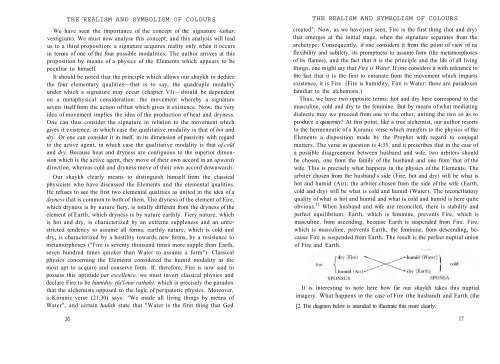Temple and Contemplation brings together for the first ... - ImagoMundi
Temple and Contemplation brings together for the first ... - ImagoMundi
Temple and Contemplation brings together for the first ... - ImagoMundi
You also want an ePaper? Increase the reach of your titles
YUMPU automatically turns print PDFs into web optimized ePapers that Google loves.
THE REALISM AND SYMBOLISM OF COLOURS<br />
We have seen <strong>the</strong> importance of <strong>the</strong> concept of <strong>the</strong> signature (athar,<br />
vestigium). We must now analyse this concept; <strong>and</strong> this analysis will lead<br />
us to a third proposition: a signature acquires reality only when it occurs<br />
in terms of one of <strong>the</strong> four possible modalities. The author arrives at this<br />
proposition by means of a physics of <strong>the</strong> Elements which appears to be<br />
peculiar to himself.<br />
It should be noted that <strong>the</strong> principle which allows our shaykh to deduce<br />
<strong>the</strong> four elementary qualities—that is to say, <strong>the</strong> quadruple modality<br />
under which a signature may occur (chapter VI)—should be dependent<br />
on a metaphysical consideration: <strong>the</strong> movement whereby a signature<br />
severs itself from <strong>the</strong> action of that which gives it existence. Now, <strong>the</strong> very<br />
idea of movement implies <strong>the</strong> idea of <strong>the</strong> production of heat <strong>and</strong> dryness.<br />
One can thus consider <strong>the</strong> signature in relation to <strong>the</strong> movement which<br />
gives it existence, in which case <strong>the</strong> qualitative modality is that of hot <strong>and</strong><br />
dry. Or one can consider it in itself, in its dimension of passivity with regard<br />
to <strong>the</strong> active agent, in which case <strong>the</strong> qualitative modality is that of cold<br />
<strong>and</strong> dry. Because heat <strong>and</strong> dryness are contiguous to <strong>the</strong> superior dimension<br />
which is <strong>the</strong> active agent, <strong>the</strong>y move of <strong>the</strong>ir own accord in an upwards<br />
direction, whereas cold <strong>and</strong> dryness move of <strong>the</strong>ir own accord downwards.<br />
Our shaykh clearly means to distinguish himself from <strong>the</strong> classical<br />
physicists who have discussed <strong>the</strong> Elements <strong>and</strong> <strong>the</strong> elemental qualities.<br />
He refuses to see <strong>the</strong> <strong>first</strong> two elemental qualities as united in <strong>the</strong> idea of a<br />
dryness that is common to both of <strong>the</strong>m. The dryness of <strong>the</strong> element of Fire,<br />
which dryness is by nature fiery, is totally different from <strong>the</strong> dryness of <strong>the</strong><br />
element of Earth, which dryness is by nature earthly. Fiery nature, which<br />
is hot <strong>and</strong> dry, is characterized by an extreme suppleness <strong>and</strong> an unrestricted<br />
tendency to assume all <strong>for</strong>ms; earthly nature, which is cold <strong>and</strong><br />
dry, is characterized by a hostility towards new <strong>for</strong>ms, by a resistance to<br />
metamorphoses ("Fire is seventy thous<strong>and</strong> times more supple than Earth,<br />
seven hundred times quicker than Water to assume a <strong>for</strong>m"). Classical<br />
physics concerning <strong>the</strong> Elements considered <strong>the</strong> humid modality as <strong>the</strong><br />
most apt to acquire <strong>and</strong> conserve <strong>for</strong>m. If, <strong>the</strong>re<strong>for</strong>e, Fire is now said to<br />
possess this aptitude par excellence, we must invert classical physics <strong>and</strong><br />
declare Fire to be humidity (fa'l-nar rathah), which is precisely <strong>the</strong> paradox<br />
that <strong>the</strong> alchemists opposed to <strong>the</strong> logic of peripatetic physics. Moreover,<br />
a Koranic verse (21:30) says: "We made all living things by means of<br />
Water", <strong>and</strong> certain hadith state that "Water is <strong>the</strong> <strong>first</strong> thing that God<br />
16<br />
THE REALISM AND SYMBOLISM OF COLOURS<br />
created". Now, as we have just seen, Fire is <strong>the</strong> <strong>first</strong> thing (hot <strong>and</strong> dry)<br />
that emerges at <strong>the</strong> initial stage, when <strong>the</strong> signature separates from <strong>the</strong><br />
archetype. Consequently, if one considers it from <strong>the</strong> point of view of its<br />
flexibility <strong>and</strong> subtlety, its promptness to assume <strong>for</strong>m (<strong>the</strong> metamorphoses<br />
of its flames), <strong>and</strong> <strong>the</strong> fact that it is <strong>the</strong> principle <strong>and</strong> <strong>the</strong> life of all living<br />
things, one might say that Fire is Water. If one considers it with reference to<br />
<strong>the</strong> fact that it is <strong>the</strong> <strong>first</strong> to emanate from <strong>the</strong> movement which imparts<br />
existence, it is Fire. (Fire is humidity, Fire is Water: <strong>the</strong>se are paradoxes<br />
familiar to <strong>the</strong> alchemists.)<br />
Thus, we have two opposite terms: hot <strong>and</strong> dry here correspond to <strong>the</strong><br />
masculine, cold <strong>and</strong> dry to <strong>the</strong> feminine. But by means of what mediating<br />
dialectic may we proceed from one to <strong>the</strong> o<strong>the</strong>r, uniting <strong>the</strong> two so as to<br />
produce a quaternity? At this point, like a true alchemist, our author resorts<br />
to <strong>the</strong> hermeneutic of a Koranic verse which transfers to <strong>the</strong> physics of <strong>the</strong><br />
Elements a disposition made by <strong>the</strong> Prophet with regard to conjugal<br />
matters. The verse in question is 4:35, <strong>and</strong> it prescribes that in <strong>the</strong> case of<br />
a possible disagreement between husb<strong>and</strong> <strong>and</strong> wife, two arbiters should<br />
be chosen, one from <strong>the</strong> family of <strong>the</strong> husb<strong>and</strong> <strong>and</strong> one from that of <strong>the</strong><br />
wife. This is precisely what happens in <strong>the</strong> physics of <strong>the</strong> Elements. The<br />
arbiter chosen from <strong>the</strong> husb<strong>and</strong>'s side (Fire, hot <strong>and</strong> dry) will be what is<br />
hot <strong>and</strong> humid (Air); <strong>the</strong> arbiter chosen from <strong>the</strong> side of <strong>the</strong> wife (Earth,<br />
cold <strong>and</strong> dry) will be what is cold <strong>and</strong> humid (Water). The reconciliatory<br />
quality of what is hot <strong>and</strong> humid <strong>and</strong> what is cold <strong>and</strong> humid is here quite<br />
obvious. 12 When husb<strong>and</strong> <strong>and</strong> wife are reconciled, <strong>the</strong>re is stability <strong>and</strong><br />
perfect equilibrium. Earth, which is feminine, prevents Fire, which is<br />
masculine, from ascending, because Earth is suspended from Fire. Fire,<br />
which is masculine, prevents Earth, <strong>the</strong> feminine, from descending, because<br />
Fire is suspended from Earth. The result is <strong>the</strong> perfect nuptial union<br />
of Fire <strong>and</strong> Earth.<br />
It is interesting to note here how far our shaykh takes this nuptial<br />
imagery. What happens in <strong>the</strong> case of Fire (<strong>the</strong> husb<strong>and</strong>) <strong>and</strong> Earth (<strong>the</strong><br />
[2 The diagram below is intended to illustrate this more clearly.<br />
17

















